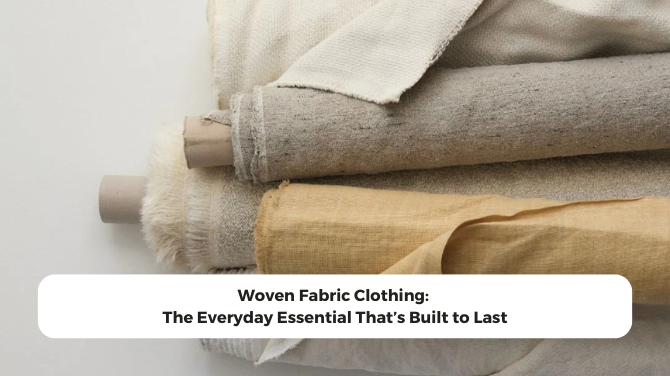Walk into any wardrobe and you’re likely to find at least a few woven pieces hanging there. Maybe it’s a crisp shirt, a pair of tailored trousers, or a lightweight cotton dress. They might not scream for attention, but they hold the outfit together. That’s what woven fabric clothing does best.
At our mill, we’ve been working with woven fabrics for decades, and even with all the innovations in textiles, this type of clothing still has a place in every collection. Whether you’re building a minimalist line or a full seasonal range, woven fabrics give you that trusted mix of structure and style.
Let’s talk about what makes them so important.
What Woven Fabric Clothing Actually Means
Woven fabrics are made by crossing yarns over and under each other on a loom. This forms a flat, stable surface that holds its shape well. It’s not stretchy like a knit, but that’s the point. It’s meant to feel clean and structured.
The clothes made from these fabrics reflect that. Think button-downs that stay crisp, pants that don’t sag, and jackets that keep their form. That’s the real advantage—woven fabric clothing holds up, both in looks and wear.
Where You’ll See Woven Fabrics Being Used
You’ve probably worn woven clothing more often than you realize. These fabrics show up in:
- Shirts and blouses
- Formal trousers
- Summer dresses
- Blazers and jackets
- School uniforms and workwear
- Cotton shorts and casual pants
- Lightweight outerwear
Woven clothing works well when the garment needs to look sharp or hold a certain shape. It’s reliable, easy to cut for tailored silhouettes, and holds design details like pleats, darts, or collars with ease.
Why Brands Keep Choosing Woven Fabrics
There’s a reason woven fabric hasn’t faded out of fashion, even with all the new textile tech. It comes down to a few simple strengths:
1. It holds its shape
Woven garments don’t stretch or lose form over time. If you’re looking for a clean look or a defined fit, this fabric makes it easier to get there.
2. Long-lasting
Because of how tightly the yarns are interlaced, woven fabrics are strong. They don’t tear easily and can handle regular use.
3. Versatile across seasons
Wovens come in all weights. Light cottons for summer shirts, heavier twills for winter coats. You can build an entire wardrobe with just woven options.
4. Smooth and stable
This makes them ideal for detailed stitching, embroidery, or prints. The fabric won’t shift around during production.
Woven Doesn’t Mean Boring
There’s a common assumption that woven equals plain or stiff. Not true. With the right yarns and finishing, woven fabrics can be soft, drapey, textured, or lightweight.
At Dinesh Exports, we work with all kinds of woven styles—from flax blends and dobby textures to yarn-dyed checks and digital prints. Some have a crisp handfeel, others are peach-finished for softness. There’s a lot more range than people expect.
Common Fabric Types Used in Woven Clothing
- Cotton Poplin: Smooth and breathable, ideal for shirts
- Linen: Lightweight and airy for warm weather
- Twill: Durable, often used for chinos and jackets
- Denim: A sturdy cotton weave for jeans or overshirts
- Chambray: Soft and light, often mistaken for denim
- Dobby or Jacquard: Adds texture or small woven-in designs
- Blends (like cotton-poly or poly-viscose): For wrinkle resistance and better drape
Each of these has its own feel and look, but they all come from the same basic weaving process.
What to Know If You’re Sourcing Woven Clothing
If you’re a merchandiser or designer planning your next line, here are a few things to consider when working with woven fabrics:
- Fit is key: Wovens don’t stretch, so the garment pattern needs to allow for comfort
- Choose the right weight: Heavier wovens work better for jackets or pants, lighter ones for shirts and dresses
- Ask about blends: A little polyester or spandex can add durability or flexibility
- Look at the finish: Brushed, sueded, enzyme-washed—these can change the handfeel dramatically
We always recommend sampling different finishes to see what fits your brand best.
Final Thoughts
Woven fabric clothing might not always be the flashiest part of a collection, but it’s often the foundation. It’s the structure behind a tailored look, the fabric that holds up after every wash, and the piece that still fits the same way next season.
If you’re building a collection that needs to feel reliable, elevated, or timeless, start with woven. It’s flexible, easy to customize, and when done right, it lasts.
Need help finding the right fabric for your next line? We’ve got digital swatches ready, and no signup is needed to browse. Just reach out if you’d like to discuss samples, MOQ, or timelines.

